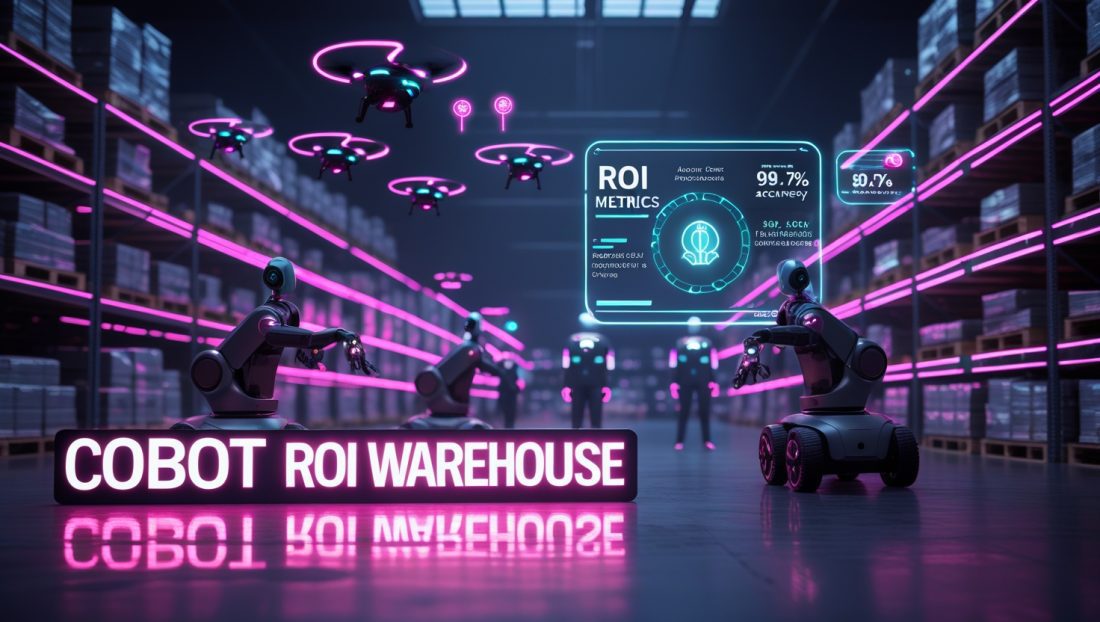What if 34% of your warehouse labor vanished overnight?
Sarah, a warehouse manager at an electronics distributor, faced this daily reality. Manual stock checks consumed her team’s productivity. After deploying collaborative robots (cobots) for inventory management, they reclaimed 250 weekly labor hours, achieving a cobot ROI warehouse managers dream of. “Our cobots paid for themselves in five months,” she confirmed.
This mirrors DHL’s experience: $200,000 monthly savings from autonomous drones conducting cycle counts. With warehouse labor costs surging 15% in 2025—four times the national average—automation has shifted from luxury to necessity.
The Warehouse Labor Crisis: By the Numbers
Warehouses hemorrhage productivity through manual processes:
- 34% of labor hours wasted on inventory checks (McKinsey)
- 85% accuracy rate in manual counts versus 99.7% with automation
- 70% of facilities report hiring shortfalls (Logistics Management 2025)
PepsiCo’s collaboration with Addverb Technologies exemplifies the transformation. Their automated system increased throughput by 36% within the same physical footprint.
Decoding 300% ROI: Where Savings Materialize
Cobot ROI Warehouse: Scaling Without Labor Spikes
Universal Robots’ cobot deployments at Fleet Feet enabled 300% higher throughput with 40% fewer labor hours. Workers transitioned to quality control and exception handling. This shift optimizes warehouse labor efficiency, a critical metric as labor shortages intensify globally. By automating repetitive tasks, cobots allow staff to focus on high-value roles, boosting morale and productivity. For instance, our guide on industrial AI implementation highlights how AI-driven systems streamline human-robot collaboration, ensuring seamless scalability without workforce expansion.
A report by Supply Chain Dive highlights how collaborative robots (cobots) are driving measurable efficiency gains in warehouse operations. Facilities adopting cobots have reported up to a 15% reduction in overtime spending and 25% fewer errors, contributing to lower labor costs and improved workflow precision. These results underscore the value of human-robot collaboration in optimizing repetitive tasks and minimizing operational strain.
Error Elimination
Dexory’s AI-powered drones scan 10,000+ warehouse locations hourly, achieving 99.9% inventory accuracy. For a mid-sized retailer, this reduced shipping backcharges by $112,500 monthly. These drones leverage real-time inventory tracking, slashing errors that plague manual processes. By integrating computer vision, they detect misplaced items instantly, a game-changer for high-volume warehouses. This aligns with advancements in computer vision robotics, which are revolutionizing defect detection and inventory precision across industries.
A 2025 report by Logistics Viewpoints explores how autonomous drones are transforming warehouse operations by improving inventory accuracy and reducing manual errors.
Space Optimization
Automated Storage and Retrieval Systems (AS/RS) increase storage density by 500%. Maersk’s automated Sydney facility stores 50% more inventory without expansion. This is critical for warehouse space optimization, especially in urban areas where real estate costs are skyrocketing. AS/RS systems use AI to dynamically adjust storage configurations, maximizing vertical space and reducing retrieval times. This efficiency ties into predictive maintenance AI, which ensures these systems run smoothly, minimizing downtime and boosting ROI.
Industrial AI: The Invisible Catalyst
While robots capture attention, artificial intelligence drives operational transformation:
- Predictive slotting: AI reduces picker travel by 55% through dynamic item placement (UPS implementation)
- Demand forecasting: Machine learning anticipates stock needs with 90% accuracy, minimizing dead stock
- Condition monitoring: IoT sensors maintain optimal storage environments for perishables
AI unlocks 7–15% more warehouse capacity while cutting logistics costs by 20%. It’s not optional—it’s oxygen for modern operations.
— McKinsey Logistics 2025 Report
Implementation Roadmap: Avoiding the $150M Mistake
A consumer goods company’s $150 million “lights-out” warehouse failed due to poor scalability planning. Follow this proven framework:
Phase 1: Process Audit & Pilot Deployment
Identify high-error or labor-intensive tasks. Start small:
- Flytrex drones for cycle counts in one zone (8-week setup)
- Universal Robots arms for palletizing (ROI <7 months)
Phase 2: Modular Scaling
Tompkins Robotics’ tSort systems allow incremental expansion. Seasonally scale AMR fleets during peak demand without infrastructure overhaul.
Phase 3: Human-Robot Integration
DHL’s model proves effective: 1 technician oversees 10 drones scanning 500,000 sq/ft overnight. Staff arrive to 100% accurate stock reports.
Phase 4: Total Economic Analysis
Use Dexory’s ROI calculator to factor:
- Labor savings ($25/hour average)
- Error reduction costs
- Revenue upside from faster fulfillment
The Hybrid Warehouse: Where Humans and Machines Coexist
Automation’s greatest value emerges in collaboration:
- Safety enhancement: Cobots reduce workplace injuries by 32% (OSHA 2024 data)
- Employee retention: 3PL firms report 40% lower turnover post-automation
- Skill elevation: Workers transition to robotics supervision and data analysis
As Anthony Pendola, Senior Distribution Manager at Fleet Feet, observed: Staff prefer managing robots over manual counts. They leave less fatigued, and we’ve seen massive efficiency gains.
Future Frontiers: What’s Next in Warehouse AI
Cognitive Automation (2026-2027)
Projected systems will:
- Self-diagnose maintenance needs
- Dynamically replan routes during disruptions
- Negotiate carrier rates via blockchain
Swarm Robotics
Early tests show drone fleets completing inventory checks 4x faster through coordinated scanning patterns.
FAQ: Addressing Critical Concerns
Can small warehouses afford robotics?
Yes. Flytrex offers drone-as-a-service from $2,500/month. Modular cobots start at $30,000 with 12-month payback periods.
How long does deployment take?
Pilot programs launch in 8-12 weeks. Full integration requires 6-9 months.
Will automation eliminate jobs?
DHL retrained 80% of staff as automation technicians. New roles focus on exception management and data analysis.
What’s the biggest implementation pitfall?
Underestimating integration complexity. Demand API compatibility between robotics and your WMS.
Your Action Plan: Start Today
- Audit workflows: Identify tasks with >15% error rates or >30% labor drain
- Calculate your ROI:
→ Download Warehouse Automation ROI Calculator - Secure financing: Vendors offer 0% interest until Q2 2026
40% of Indian warehouses will automate fully by 2030. The question isn’t if—it’s how fast you’ll adapt.
— Addverb Technologies 2025 ForecastExplore Solutions
Subscribe to our Newsletter for Updates
Get monthly robotics implementation insights



